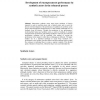Free Online Productivity Tools
i2Speak
i2Symbol
i2OCR
iTex2Img
iWeb2Print
iWeb2Shot
i2Type
iPdf2Split
iPdf2Merge
i2Bopomofo
i2Arabic
i2Style
i2Image
i2PDF
iLatex2Rtf
Sci2ools
IWEC
2004
2004
Development of Extemporaneous Performance by Synthetic Actors in the Rehearsal Process
Autonomous synthetic actors must invent variations of known material in order to perform given only a limited script, and to assist the director with development of the performance. In addition, the synthetic actors need to learn through the rehearsal process, as their human counterparts do, via feedback from the director. Through the production of two performances, involving both human and synthetic actors, a variety of methods of creating extemporaneous performance and utilising feedback to select the most effective performance variations will be examined. One method of varying the performance is the manner in which lines of dialogue are delivered. The paper outlines use of a statistical technique to create three variations of a performance; each variation was then ranked, and these rankings used to weight the variances in individual lines to create a superior variation. This allowed quick evaluation of many lines, without having to score each individual line. Synthetic Actors Synthe...
| Added | 31 Oct 2010 |
| Updated | 31 Oct 2010 |
| Type | Conference |
| Year | 2004 |
| Where | IWEC |
| Authors | Tony A. Meyer, Chris H. Messom |
Comments (0)

